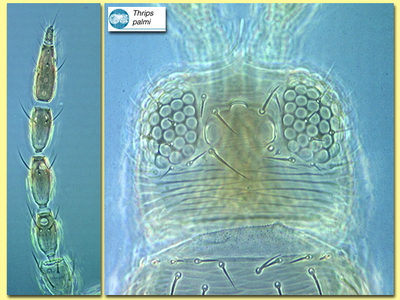Figures
Fig. 1 Antenna and head (dorsal)
Fig. 2 Pronotum
Fig. 3 Meso- and metanotum
Fig. 4 Fore and hind wing
Fig. 5 Sternite VI and VII
Fig. 6 Tergite and pleurotergite VIII
Fig. 7 Tergite VII and VIII (female)
Species
Thrips palmi Karny
Biology
Highly polyphagous, breeding in the flowers and on the leaves of several important crops such as cucurbits, capsicums and orchids.
Distribution
Originally from south east Asia, but increasingly found in most parts of the wet tropics.
Recognition
Small sized yellow thrips, with forewing pale and distal antennal segments light brown. Antennae 7-segmented, III & IV with sense cone small and forked. Head with no setae in front of fore ocellus, one pair on anterior margins of ocellar triangle just behind fore ocellus. Pronotum with 2 pairs of posteroangular setae. Metanotum with curving ("smiling") transverse lines of sculpture at anterior, but elongate reticulation on posterior half with lines converging posteriorly; median setae not at anterior margin. Forewing first vein with 3 setae on distal half. Tergite II with 4 lateral marginal setae; V-VIII with ctenidia laterally, on VIII posteromesad of spiracle; posteromarginal comb on tergite VIII long and irregular. Sternites and pleurotergites with no discal setae.
Related species
Amongst the 280 species of the genus Thrips, this species has most characters in common with two Indian species, and with Thrips flavus, and T. tabaci.








